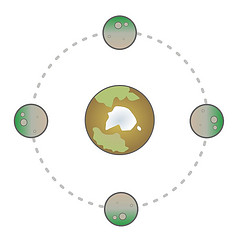
If the moon orbits the earth, always presenting the same face to us, does it rotate on its own axis?
It seems a simple question, but its appearance in the London Times in April 1856 set off a war among the English intelligentsia:
- “A ship sailing round the world presents to the fishes always the same face as the Moon does to us. Coming home again, it will surely not be said that the ship has performed a [rotation].”
- “Let him perforate a small ivory ball to represent the Moon, pass a wire through it, and bend this wire into a circle of a foot in diameter, and then push the ball round the circumference. Will there then remain any doubt of her not rotating on her axis?”
The answer, as William James would note in his parable of the squirrel, is that “which party is right depends on what you practically mean” by the term in question. Today we’d say that the moon rotates about its axis in the same time it takes to orbit the earth.
Incidentally, Lewis Carroll submitted two letters, but the Times didn’t print them. Perhaps it’s just as well — he was far ahead of everyone else: “I noticed for the first time the fact that though [the moon] only goes 13 times round the earth in the course of the year, it makes 14 revolutions round its own axis, the extra one being due to its motion round the sun.”
